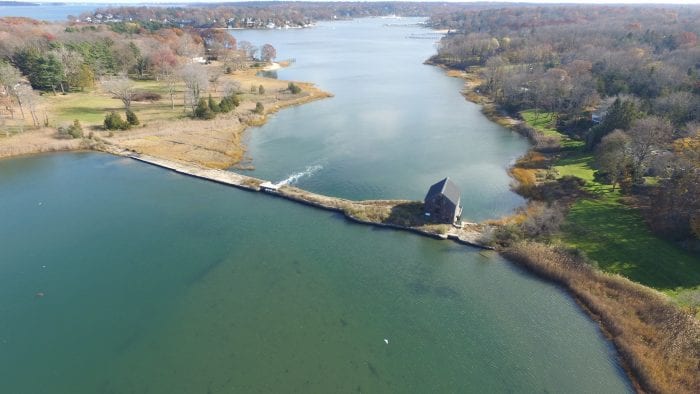Gardiner Foundation Awards Tide Mill Sanctuary Nearly $100,000

One of the oldest industrial buildings on Long Island is about to get an upgrade.
The Van Wyck-Lefferts Tide Mill Sanctuary recently announced in a press release that the Robert David Lion Gardiner Foundation awarded it a grant of more than $97,000. The matching grant will go toward the restoration of the 223-year-old Van Wyck-Lefferts Tide Mill in Lloyd Harbor and the dam where it is located.
The tide mill sanctuary is a nonprofit established to preserve and promote public access to the three and one-half story 18th-century tide gristmill. Both the timber-frame wood tide mill and the 400-foot long earthen dam are listed on the National Register of Historic Places.
“The Robert David Lion Gardiner Foundation’s mission is to advance Long Island’s regional history,” said Kathryn Curran, executive director of RDLGF. “All projects chosen to receive RDLGF funding each have their own individual impact, but mark a shared place in a larger story. The Van Wyck-Lefferts Mill is one of many local mills that dot this Island, each representing commerce, community devolvement and technology.”
According to the tide mill sanctuary, the grant will help to restore the earthen dam. The nonprofit will also be able to install a new roof on the mill building and do interior structural repairs. This work is expected to be completed in the middle of this year.
“The mill is considered one of the best preserved 18th-century tide mills in the United States and is one of only 10 surviving examples of tide mills in the northeast from Virginia to Maine,” said Robert Hughes, tide mill sanctuary board member and Town of Huntington historian. “The funding from the Gardiner Foundation will help to ensure the continued preservation of this remarkable structure, which was built in 1797 and continued to serve local farmers for the next three-quarters of a century.”
In the future, the nonprofit also hopes to shore up the bulkhead, which protects the mill’s stone foundation, and to restore the bridge over the spillway that connects the north and south sections of the dam.






